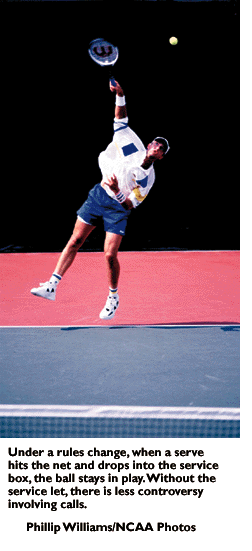The NCAA News - News and FeaturesMarch 2, 1998
Let play continue
A major tennis rule change allows the ball to remain in play when it hits the net on a serve
BY VANESSA L. ABELL
STAFF WRITER
 A major rule change in Division I men's tennis this year involves the elimination of the service let. A major rule change in Division I men's tennis this year involves the elimination of the service let.
The new rule states that when a serve hits the net and drops into the service box, the ball remains in play. Before, when a served ball made contact with the net, the serve was repeated without penalty to either competitor. Now, any time a ball hits the net, the ball remains in play -- regardless of whether on a serve or volley -- and a failure to return the ball results in a loss of point.
The new rule was adopted by the Intercollegiate Tennis Association Rules Committee, the ITA Men's Operating Committee and the ITA general membership last spring and has been used in collegiate competition since last fall.
NCAA tennis uses United States Tennis Association (USTA) rules as modified by the ITA. The NCAA tennis committees automatically adopt ITA rules for the Association's men's and women's tennis championships, unless they vote to do otherwise.
Dave Fish, Harvard University men's tennis coach, was involved in efforts to achieve elimination of the service let. As a member of the former Association-wide Men's and Women's Tennis Committee, Fish proposed the rule change to the ITA Coaches Convention in December 1996.
"It has been a very useful experiment," he said. "None of us knew how it worked until we tried it."
Several benefits listed
Supporters of the no-service-let rule cite several benefits.
Without the service let, any controversy surrounding a call has been eliminated. Competitors no longer have to rely on an official calling a service let.
Many collegiate matches are not fully staffed by officials. Other tennis competitions are not refereed at all. Some decisions are made by the players on the court, and they don't always see things the same way.
Even when officials are present, they may be busy watching three matches at one time. It is difficult for them to accurately call every serve that may hit a net. Only at the professional level of play are officials available to touch the net for evidence of let-cord contact on a serve.
With the elimination of the service let, opponents play on regardless of net contact.
Boise State University men's tennis coach Greg Patton supports the new rule. He believes it "takes the hassles out of the game. It saves the controversy. If it is in, it is in. If it is out, it is out."
Some observers even believe the new rule pushes athletes to a higher level of performance.
More strategy results from allowing a serve to hit the net. Players need to prepare for play at the rear of the service box up to the net's edge. Elimination of the service let adds a new dimension to the game.
Backers of the rule also believe that it shortens the length of the match -- although the difference isn't dramatic. It does allow play to continue more quickly without the constant repetition of serves.
"It keeps the matches going a little bit," Patton said.
Doubts change improved the game
But not all coaches like the rule change.
"It was done to spice up the game. I don't see how it has made the game better," said Matt Anger, University of Washington men's tennis coach and chair of the Division I Men's and Women's Tennis Committee. "No one is flocking to the tennis courts because they are now playing lets."
Anger acknowledges that the rule change does have one positive aspect: "It eliminates a judgment call where there can be a dispute."
However, he doesn't believe that the time saved with no-service-let play is significant. He says, "It saves maybe 30 seconds or maybe a minute off of a match."
Student-athletes are adapting to the rule. Although there has been some hesitation in playing a serve off of the net, the players are learning to adjust.
Understandably, when the rule works against them, players have complained about the rule change. But that opinion typically changes when their next serve hits the cord to their advantage.
Some players have observed that the new rule may take away some competitive advantage from taller players who may have a huge first serve.
Interested in feedback
Anger will be interested in hearing feedback on the rule at this year's Division I Men's Tennis Championships at the University of Georgia. Division I coaches will be surveyed in April for that feedback. The ITA groups that made last year's decision will review the survey results at the championships and will decide whether to retain the rule in Division I play.
Some in collegiate tennis see the rule as part of the evolution of men's tennis.
As the sport continues to grow, there is interest in keeping the game action-packed and in promoting the athleticism of collegiate players.
For now, World Team Tennis is the only other tennis group utilizing the no-service-let rule. But collegiate tennis may be setting trends with the no-service-let rule and other changes that other tennis governing bodies may follow.
|